
Individual books aren’t terribly expensive, it’s true. You can often get a new hardcover for $25-30, and a new paperback for $10-15.
But even buying just one hardcover a month will cost roughly $300 a year. And what if you get a book a week? Or you’re ordering textbooks for college? You could easily spend a small fortune.
Reading books and supporting bookstores and authors doesn’t have to be so expensive. There are plenty of alternatives to buying books, or ways to reduce their costs by as much as 90%.
So whether you’re a reader looking to embrace frugal living, a student eager to save money in college, or just want to know how to make your money go the extra mile (less money on one book means you can buy more books, amirite?), these tips will help you save money and read more.
1. Get a library card
“Having fun isn’t hard when you’ve got a library card.” That’s what the TV show Arthur taught me as a kid, and honestly, I sing this song way more often than I’d like to admit. Because that aardvark is right.
One of the cheapest ways to read books is to use your local library. The library is one of the few remaining public places you can visit where the expectation isn’t that you’ll spend money.
Signing up for a library card lets you borrow more than just books at no cost: Libraries also have video games, DVDs and Blu-rays, CDs, board games, and any number of eclectic things for check out. They often host community events and get togethers, from book clubs to yoga sessions to anime-watching nights. Plus, you can even get free or discounted passes to local attractions — like museums — with your library card.
If you like to read or listen to books digitally, a library card gives you access to apps like Libby and hoopla.
The bottom line is, there’s no reason not to sign up for your local library.
2. Sign up for Everand or another digital book subscription service
Prefer ebooks and audiobooks over print books and CDs? Then an Everand subscription might make sense for you.
Everand is your home for stories and knowledge where you can discover millions of ebooks, audiobooks, podcasts, magazines, newspapers, sheet music, and so much more. With Everand, reading multiple books a month is cheaper than the price of one paperback.
Wired put Everand as the best overall app on its “Best Ebook Subscription Services for Every Kind of Reader” list (which includes other options for your consideration, from Kindle Unlimited and Kobo Plus to Audible and Spotify).
3. Borrow books from friends
If you’re a big reader, chances are your friends are, too. You’ve all probably got decent collections going already, and know each other’s tastes. So why not borrow books from your friends, who will know exactly what to recommend based on your favorite tropes and your worst squicks?
In high school, my friends and I were big into manga (before manga was cool). Since libraries weren’t stocking tons of manga yet, my friends and I arranged it so that different people bought different series with our limited allowances, and we borrowed volumes from each other. We essentially became our own little manga library with our pooled resources, and it was great fun.
Borrowing from friends isn’t just a fantastic way to save money or discover new books: It’s a way to get closer to your friends, too. You’ll likely spend an hour talking about your likes and dislikes after finishing whatever books you’ve borrowed. (That’s not just me and my cohort, surely?)
4. Check out Little Free Libraries in your neighborhood
I have a Little Free Library installed in my front yard, because lots of people walk along my street and few cars drive down it. Plus, there are apparently lots of readers in my neighborhood, because the box is always full of new books for people to take.
If you’re unfamiliar with Little Free Libraries, here’s the gist: People leave books in a book exchange box, or take books that they like from inside the box — for free. Generally, these are used books that people are donating for various personal reasons, from not vibing with the story to just wanting to declutter.
You can look up locations of Little Free Libraries near you on the website’s map. While not every book exchange box is an official LFL, and not every LFL is registered to the organization’s map, checking it is a good starting point.
5. Buy used books
Why pay full price for a book when you could get it 50%, 75%, or maybe even 90% off? Those are the kinds of discounts that come with buying a book used instead of new.
I recently bought a used copy of David Foster Wallace’s massive tome Infinite Jest for $11 on Thriftbooks, instead of the requisite $23 at Barnes & Noble (or a whopping $40, if you want it in hardcover). The price often corresponds to the condition of the used book you’re buying: The more “like new” it is, the closer to retail price it will be. If it’s full of scribbles from a previous owner who loved it lots, then it will likely cost less.
Some of the cheapest places to buy used books are local, physical used bookstores. It’s well worth looking up used bookstores in your area and taking a short drive to browse their bargain bins.
Buying used books isn’t just good for your wallet, it’s good for the planet, too. “Over the coming decade, the global book industry is on-track to bulldoze woodlands more than four times the size of Wales — up to a staggering 3.4 billion trees,” according to a climate change opinion column from 2021 by Donnachadh McCarthy in The Independent.
So save the forests and buy used books. Going green will also save you in greenbacks. It’s a win-win.
6. Sign up for a book subscription box
Monthly book subscription boxes can be — but aren’t necessarily — cheaper than purchasing a hardcover book. However, if you tend to go to the bookstore for one book and leave with five, then signing up for a subscription box still might help cut down your impulse purchases.
Book subscription boxes, like Book of the Month, are great for readers who want to keep up with new releases. Others in the space, like OwlCrate, which focuses on Young Adult books, add goodies to the boxes, as well, like pins, stickers, and more.
The best part about book subscription boxes is the anticipation. What will be in the box this month? Will you like it? Finding a box that fits your likes is a must if you’re a reader who obsessively watches unboxing videos.






